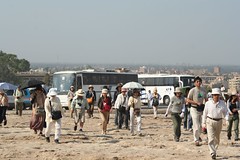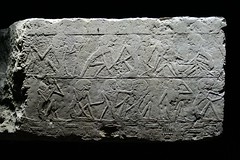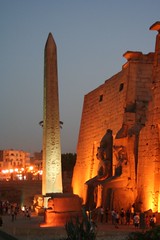
Click on pic to see slideshow
or here to access the Pyramid set
Shoving everybody out of their way, a large group of visitors make their round around the Narmer palette in the first floor atrium of the Egyptian Museum. I stand my ground in front of one of the sides of the display - they will have to tolerate my presence and move around. I pretend to read the display but instead I listen to what their English-speaking guide is saying – in a few words, without wasting any time (he must soon vacate the place for his colleagues who are coming behind, leading other groups), he tells them pretty much what the Lonely Planet Egypt travel guide has taught me about this famous artifact. They look, listen, and then are shepherded away before anybody has any questions. Alone at last, I try to focus on the detail of the fine engraving portraying the pharaoh victorious over his enemies, but I soon become distracted again – on my left, a large group of Russians passes by, following an Egyptian museum guide who seems to speak fluent Russian. The Russians are a sight to behold – quite a few men wear “wife-beater” tank-tops stretching over protruding beer-bellies and the women, young and old, wear high heels and skimpy outfits, their cleavages pushed to night-club limits, their shorts stopping at the buttocks. I wonder if they plan to go in the area of town called “Islamic Cairo”... What sort of mad attention would these girls attract on the streets in this country where the local women only show their faces and hands in public, if anything? But these Russian “nouveaux riches” (who else in Russia can afford to travel abroad?) will probably be swept from the museum back to their hotel in their tour bus, and from there to the pyramids, then maybe into a felucca or motor boat commissioned specially for the group for a one-hour Nile cruise. They probably haven’t ever dreamed of visiting a mosque and wouldn’t be allowed in anyway, dressed like they are.
The museum, if you ignore the crowds and the bellowing guides, makes for a very interesting visit. A large part of the second floor is dedicated to housing the treasures of Tutankhamun’s tomb; these beautiful works of funerary art are definitely worth your time. The royal mummies are tucked in their temperature-controlled glass cases in an air-conditioned room. You pay extra to get in, but if you have never seen a mummy, now’s the right time – all the famous, identified pharaohs’ remains are there and some of them still smile quite nicely. However the museum can easily put you into “pharaonic overload” mode; most of it resembles a large warehouse where sarcophagi, statues, miniatures and slates covered with hieroglyphs, thousands of years old, are piled up with no explanations, in rooms that have long overflowed their capacity. A couple of hours spent inside will leave you longing for things anything-but-historical, like the restaurants and cafés of the Hilton hotel nearby.
Once you’re done with the museum, it’s time to head to the archaeological sites around Cairo. Everybody stops at the famous pyramids of Giza, the suburban neighborhood which sprawls almost to the base of the pyramid of Khufu (Cheops). If you’re not on a tour group, you can get there by bus, metro and taxi, but the best way is to hire a driver for the day and also visit the other pyramid sites, which are out of the beaten track – Saqqara and Dahshur. These get their share of visitors as well, but nothing like Giza; and if you get there early enough, you may have the place all for yourself. Sure, the pyramids of Khufu and Khafre will tower over you, covering the sun, and will make you feel like a gnat, but the Step Pyramid at Saqqara, so different and having the privilege of being the oldest of them all, gets a standing ovation. And if you don’t want to pay the extra ticket to get inside the pyramid of Khufu, and wait in line with the crowds, while being hassled by camel-ride touts and guards who want baksheesh, you can clamber down the shaft into Sneferu’s Red Pyramid at Dahshur – if you can stand the strong smell of ammonia in the funerary chamber. Sadly, the most intriguing of all pyramids, the Bent Pyramid of Dahshur, still covered by its original shiny limestone casing, is closed to public and can only be seen from afar.

Click on pic to see slideshow
or here to access the Luxor set
In Aswan, for reasons that I have already mentioned, we did not see any of the famous landmarks. But in Luxor - aka the tourist hassling capital of Egypt - we didn’t make friends with any local people and concentrated on the many famous ancient sites. The heat in southern Egypt is terrible, even in November, and forces the masses of tourists to wake up early and visit the temples of Luxor and Karnak and the Valley of the Kings as early in the morning as possible, before the sun becomes unbearable. The Luxor temple is smack in the middle of the modern-day Luxor town, and Karnak is a mere 3 km ride along the Nile – easy and fast done by taxi or by one of the omnipresent horse-drawn carriages whose drivers, like most other touts, will try to charge you a small fortune and ask for ‘baksheesh for the horse’ (don’t give, although it’s funny). The Valley of the Kings however, is on the other side of the Nile, and getting there is not a breeze. You can rent a bike, cross the river by ferry, and pedal yourself to death between the sites – not a good idea after 11am, unless you have a secret death wish. You can hire a taxi for the day, which will cost you dearly if you don’t negotiate properly, and you will be the one who decides when and where to go. The most comfortable alternative is to take a tour organized by your hotel (I dare you to find a hotel in Luxor which doesn’t provide this service). It will include a guide (whose English you will hopefully be able to understand) and all the entrance fees. You’ll have to share a mini-bus with other people; ask how many and make sure the bus is air-conditioned – you may still be lied to, but at least you know it. Invariably, you will be taken to one of the many “Alabaster factories” which proliferate in the shadow of the ancient tombs. There are so many of those stone-carving workshops, that one cannot help but ask how they are able to stay in business. There is only one answer: everybody who owns an alabaster factory must have a brother or an uncle who organizes tours of the valley, who in turn has a brother or an uncle who owns or manages a hotel or a cruise ship. This way the tourists are given the whole deal – hotel, visit to the valley, alabaster shopping. Some even buy souvenirs for their living rooms and everybody is happy and the wealth is redistributed along the chain.
If you are ready to fight the crowds and eager for hieroglyphs, if you can negotiate prices and have enough sun-block, there’s one more thing you shouldn’t forget: your international student card – it will be the your wallet ‘s best friend. Every entrance fee in Egypt – and some places aren’t cheap to get in - is half-price for students; the ISIC cards rule in the land of pharaohs. And don’t be bitter when you find out that while you pay a lot, even with your student discount, Egyptians pay 2 pounds. Half if they are students… After a day in the Valley of the Kings you’ll wish you’d rather be Egyptian…
Posted from Nafplio, Greece.






1 comment:
King Djoser was the great pharaoh in the old kingdom. I read informative article about Djoser at Djoser (2687-2668 BC)
Post a Comment